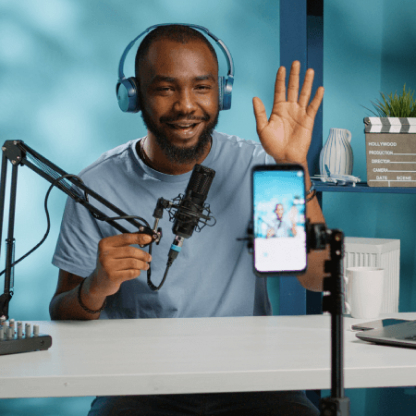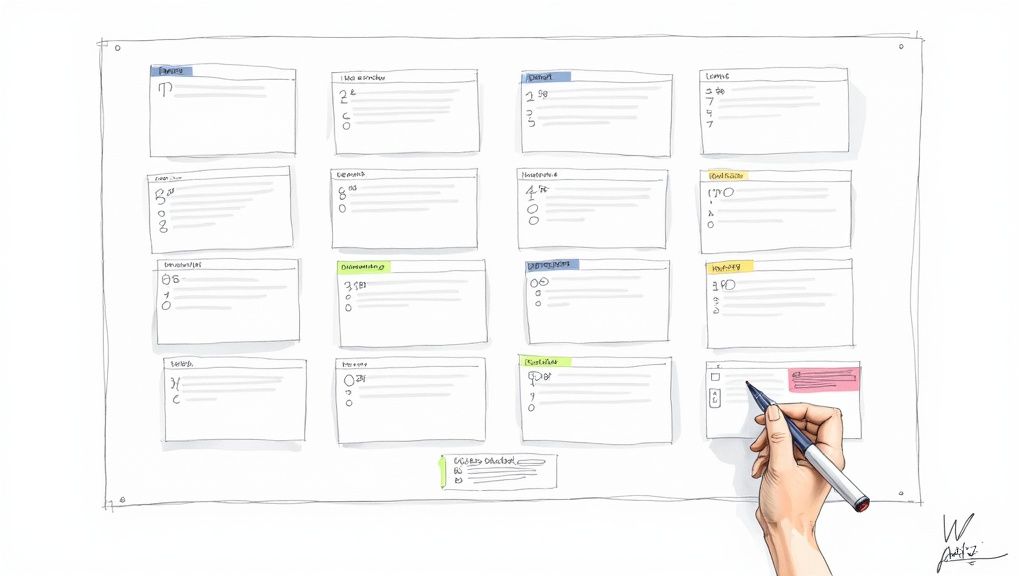Let's be real. Your inbox is a graveyard of resumes. They all blur together, right? Same buzzwords, same Canva templates. Your gut screams that 90% of them are a waste of time, but you’re stuck sifting through every single one like some kind of HR archaeologist. This isn’t just inefficient—it’s a soul-crushing, resource-devouring nightmare.
The Real Cost of Ignoring Pre-Screening
Consider this your wake-up call. We're about to show you what it really costs to interview unqualified candidates. And no, we’re not talking about a few wasted hours. We're talking lost team productivity, sinking morale, and the very real financial risk of a bad hire.
Forget the fluffy HR jargon. This is a founder-to-founder chat about why pre-screening isn't a 'nice-to-have' feature. It’s the only thing standing between you and a tidal wave of bad fits.
The $500 Hello
Every "quick chat" with an unqualified candidate is a tax on your team's focus. It yanks your best people away from building your company to vet someone who never had a shot in the first place. Hope you enjoy spending your afternoons fact-checking resumes—because that’s now your full-time job.
This isn't just about lost time. The financial hit adds up fast. Just look at the direct costs of skipping email verification and other basic checks. You're literally burning cash on salaries for time spent on zero-ROI activities.
A bad hire isn’t just a performance problem; it’s a financial sinkhole. The U.S. Department of Labor estimates the cost of a bad hire can be up to 30% of their first-year salary.
This isn't theory. The numbers are screaming at you to filter candidates before they ever speak to a human.
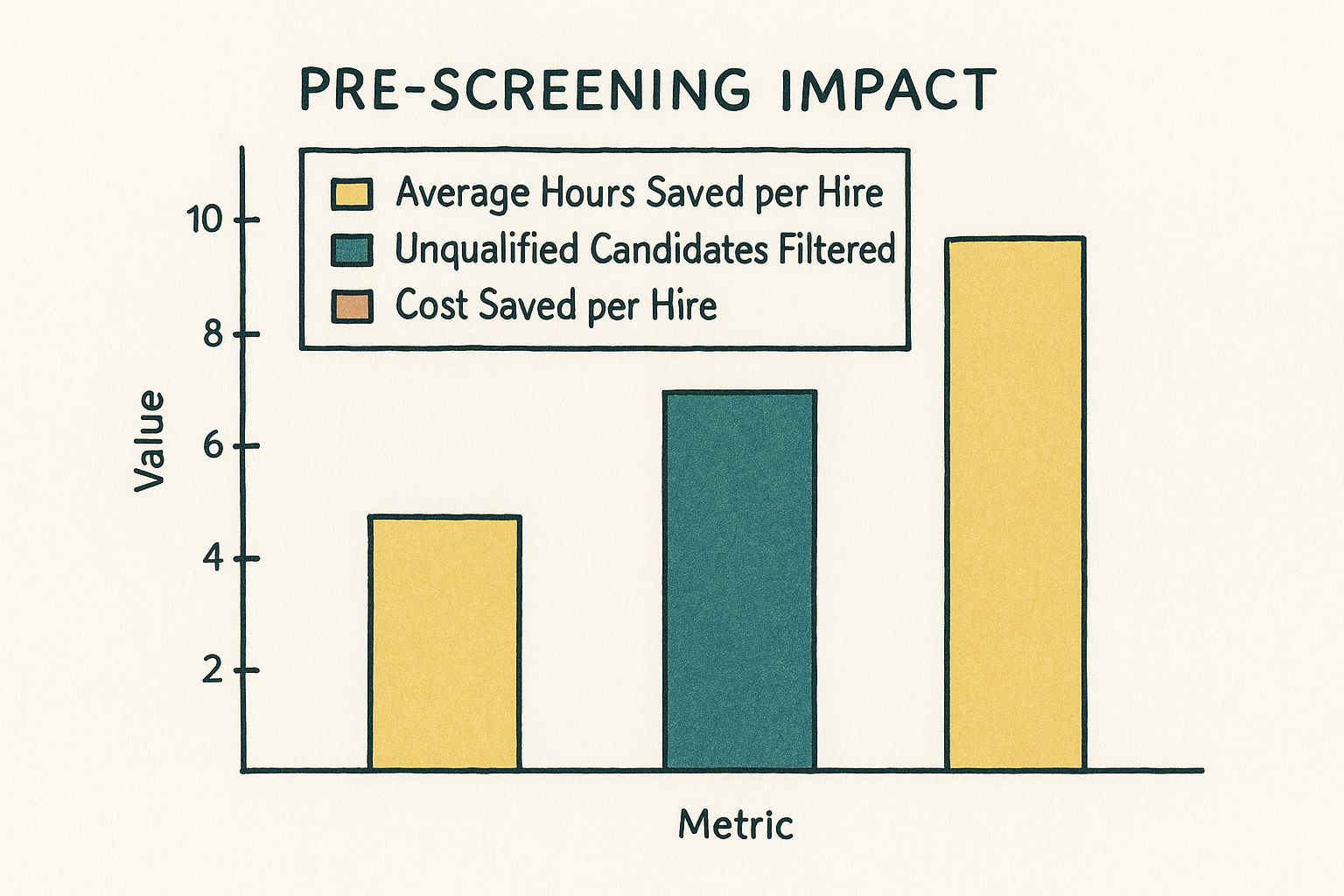
The data is painfully clear: A smart pre-screening process isn't an expense. It's an investment that saves you a mountain of time and money on every single hire.
Hiring With vs Without Pre-Screening: A Reality Check
To really drive this home, let's put the two approaches side-by-side. This isn't a minor tweak; it’s the difference between structured, data-driven hiring and chaotic, expensive guesswork.
| Metric | Traditional Hiring (No Pre-Screening) | Smart Hiring (With Pre-Screening) |
|---|---|---|
| Initial Candidate Pool | 100% of applicants, including the wishful thinkers and bots. | Top 20-30% who actually meet the core job requirements. |
| Hiring Manager Time | Wasted on calls with fundamentally unqualified people. | Focused on high-value conversations with vetted, promising talent. |
| Time-to-Hire | 45-60 days (or more) of slow, painful grinding. | A brisk 20-30 days. |
| Risk of a Bad Hire | High. Decisions are driven by gut feel and resume keywords. | Low. Decisions are grounded in objective, verified data. |
The contrast is stark. One path leads to burnout and bad hires. The other leads to faster, smarter, more reliable outcomes. The choice seems pretty damn obvious.
What Pre-Screening Actually Means (The No-BS Version)
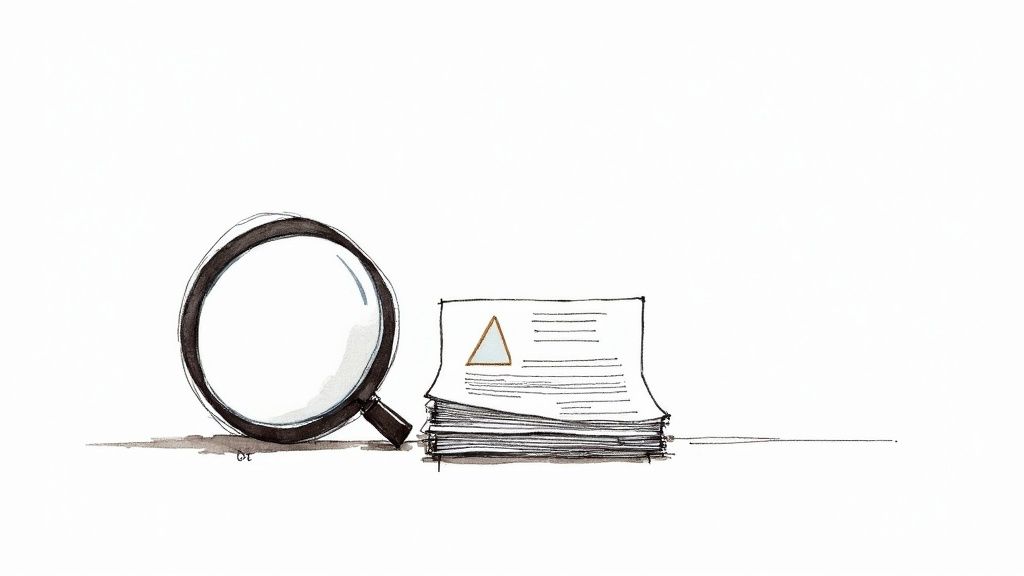
Let's cut the jargon. What does pre-screening look like when the rubber meets the road? It’s not some deep-dive investigation into every person who clicks "apply." Not even close.
Think of pre-screening as the bouncer for your talent pipeline. Its only job is to check if a candidate meets the absolute, non-negotiable requirements before they steal a single second of your team’s time. This isn’t about finding your next rockstar. It's about efficiently kicking out the definite "no's" so you can focus on the potential "yeses."
It's a simple, objective gate. Can they legally work here? Do they have that mandatory license? Are they available during the required hours? These are the knockout questions—clear, factual, and easy to automate.
A Lesson from Clinical Trials
Honestly, the best analogy comes from a totally different world: clinical trials. Before researchers run expensive medical tests, they have an initial pre-screening phase. It's a quick check based on simple, self-reported info—like age or a specific health condition—to see if someone is even eligible. This fast, low-cost step ensures they don't waste precious resources on the wrong person.
Pre-screening is your first line of defense. It’s not the full battle—it’s the quick checkpoint that decides who even gets on the battlefield.
You wouldn't test a drug on someone who doesn't have the disease, so why would you interview a developer who doesn’t know the required coding language? The entire pre-employment screening process is built on making smarter, faster decisions from the start.
Now, let’s clear this up. Confusing pre-screening with deeper screening is a rookie mistake that creates a messy, ineffective hiring process.
Think of it like this:
- Pre-screening asks: "Do you have a driver's license?" A quick, yes/no check.
- Screening asks: "Okay, now parallel park this semi-truck on a hill." The real-deal skills test.
One confirms the basics; the other tests for actual capability. Getting this right changes everything.
The Right Tool for the Right Job
Pre-screening always comes first. It’s your fast, automated filter for things like work authorization, required certifications, or location. Its only job is to weed out the 80% of applicants who are objectively not a fit, long before a human on your team lays eyes on them.
Deeper screening comes later, and it’s much more hands-on. This is where you bring in the human element for:
- In-depth interviews
- Technical skill assessments
- Culture-fit conversations
The first stage is about qualification; the second is about validation.
This separation is crucial in high-stakes fields. Take clinical trials again. The deep medical assessment, known as clinical trial screening, only happens after a candidate passes the initial pre-screen. Guides on clinical trial basics show how intense this deeper screening is—it’s designed for total safety and eligibility.
When you mix these up, you waste your team’s time asking basic questions a simple form could have handled.
Building Your Pre-Screening Playbook
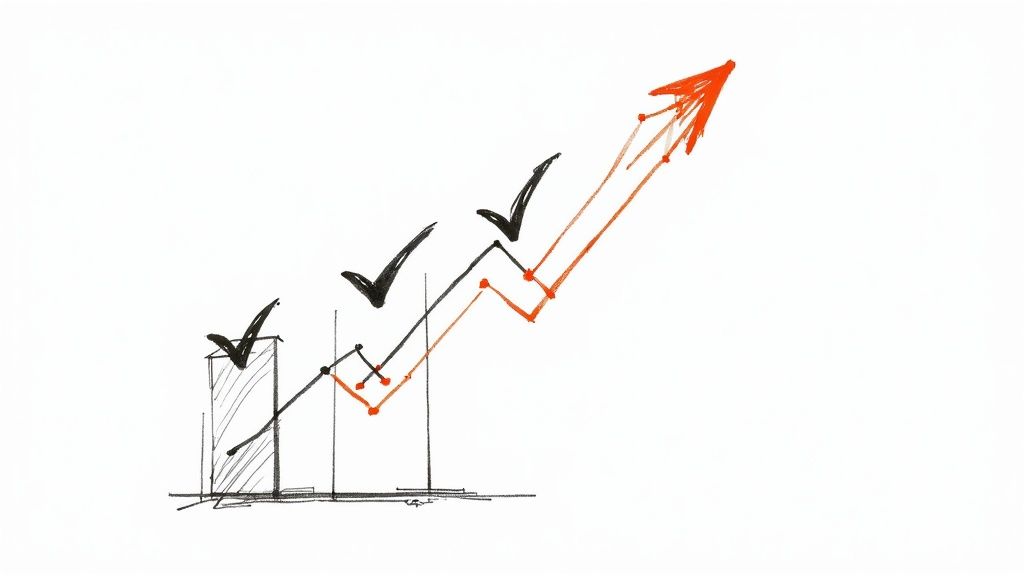
Alright, enough theory. How do you actually build a pre-screening process that works instead of creating more bureaucratic sludge? It’s not complicated; it’s about discipline. Be ruthless with your criteria so you don’t have to be ruthless with your time.
This first step isn't about finding the perfect person. Not yet. It’s about building a filter that instantly weeds out the wrong people so you can free yourself from manually sifting through every resume.
Start with Knockout Questions
First, define your non-negotiables. These are the handful of questions that will immediately disqualify a candidate. No debates, no second thoughts. If they can't say "yes," they're out. End of story.
Keep these questions simple, objective, and binary.
- Legalities: Are you legally authorized to work in [Country]?
- Certifications: Do you hold the mandatory [License/Certification] required for this role?
- Logistics: Can you work the required [Shift] or commute to our office?
These aren't "nice-to-haves." They're the absolute minimum bar for entry. If you can't get clear on these, you're just making more work for yourself later.
A great playbook doesn’t add steps; it makes the first step so effective the rest of the process gets exponentially easier.
Sharpen your thinking by borrowing from a B2B intent data playbook. Both disciplines are about spotting the strongest signals of suitability early to avoid wasting time on dead ends.
Now, with your questions defined, get the right tools. You can start by building these questions into your application form. For a real upgrade, use automated tools for skills challenges or one-way video screens. The key is to automate the "no" so your team only ever sees the "maybe."
How a Smart Filter Drives Company Growth
This might sound dramatic, but a strong pre-screening process is a competitive advantage. While your competitors are stuck in an endless loop of first-round interviews with duds, your team is talking exclusively to high-potential candidates.
What does that mean for you? Faster hiring, less frustrated managers, and a higher-quality team. You're not just saving a few hours; you're building a more lethal organization.
Your Company's Immune System
The best way to think about this is to borrow an idea from public health. The World Health Organization uses screening to identify at-risk individuals early to enable intervention. It’s a simple act with a massive downstream impact.
Your pre-screening process is your company's immune system. Its job is to neutralize threats—unqualified applicants—before they can drain resources and slow the whole system down.
This isn't just a hiring concept. It extends to other critical areas. Take LLM-powered call scoring to improve customer support. Same principle: filter for quality upfront to get better results on the back end.
A well-oiled filter ensures only the right people enter your hiring ecosystem. For a deeper look, check out our guide on automated candidate screening. It’s the key to protecting your company’s health.
Stop Wasting Time, Start Winning at Hiring
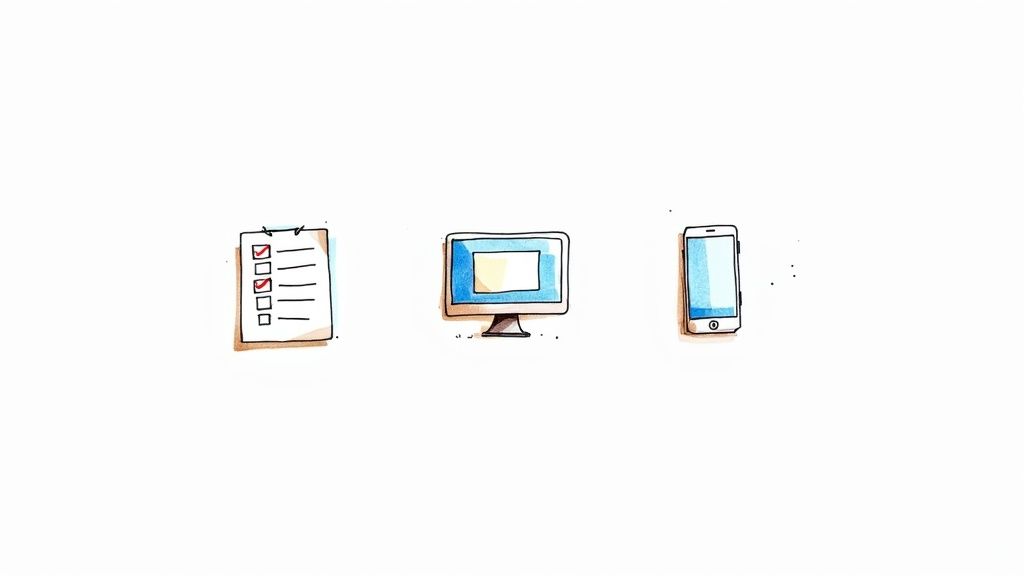
Let’s be honest. You can stick with the old routine. Keep playing résumé roulette, crossing your fingers while you drown in applications and burn afternoons on dead-end "intro calls."
Or you can get strategic.
Pre-screening isn’t about adding another tedious step. It’s about installing a smart filter that gives you back your most precious resource: time.
This lets you pour your energy into candidates who have a fighting chance of being great, not just the ones who look good on paper. Stop paying huge agency fees for so-so results. It's time to take command of your own talent pipeline.
What is pre screening? It's your secret weapon. It’s the deliberate choice to step out of the hiring chaos and start setting the terms for your own success.
The best time to fix a broken process was yesterday. The second-best time is right now.
Frequently Asked Questions About Pre-Screening
Let's cut the crap and tackle the common questions. No jargon, just straight answers.
Is Pre-Screening the Same as an Assessment Test?
Not even close. They serve two totally different purposes.
Pre-screening is the bouncer checking IDs. It's a quick, objective, yes/no check: "Do you meet the absolute minimum requirements to be here?"
An assessment test is the first round of the dance-off inside. It’s where you evaluate skills with a coding challenge, a sales pitch, or a writing sample. One checks the basics; the other starts measuring talent.
Can Pre-Screening Introduce Bias?
It absolutely can—if you do it wrong. If you use subjective or irrelevant questions, you're building a fast track to biased hiring.
The secret is to keep your pre-screening questions brutally objective, job-focused, and tied to non-negotiable requirements. A well-designed pre-screen actually reduces bias by measuring every applicant against the same impartial standard. It kills the "gut feeling" hires that come from a quick resume glance.
What Are the Best Tools for This?
For low-volume hiring, adding a few knockout questions to your Applicant Tracking System (ATS) can work wonders.
But when you're facing a flood of applications, you need more firepower. This is where tools for smart hiring with one-way interviews become a lifesaver. They automate the "no's" so your team can pour their energy into the promising "maybes" and definite "hell yeses."
Stop letting your inbox run your workday. With Async Interview, you can install a powerful filter that gives you back your time and sanity. Our platform automates the tedious first steps, letting you focus only on candidates with real potential. Toot, toot!
